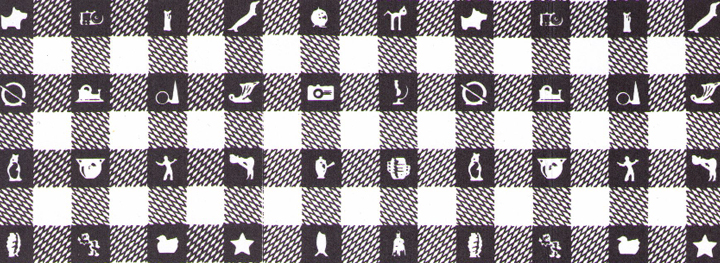Art & Art History
Ingenious Fabrications

Gallery 400
400 South Peoria Street, Chicago, IL 60607
James Carpenter, Tony Costanzo, Roy De Forest, Richard DeVore, The Reverend Howard Finster, Tina Girouard, Rebecca Howland, Steven Keister, Roy Lichtenstein, Robert Morris, Joseph Nechvatal, Louise Nevelson, Italo Scanga, Pat Steir, Anita Thacker, Robert Venturi, Betty Woodman, Claire Zeister, Harry Anderson, Juanita Mizuno, Ned Smyth, and Will Stokes
Ingenious Fabrications presents approximately 35 practical and conceptual works incorporating silk-screened fabric designed by artists, craftspeople, and architects at the Fabric Workshop in Philadelphia. The Gallery 400 exhibition highlighted diverse projects that ranged from the practical to the purely decorative to provocative political commentaries. The lively installation featured a large dining tent, doorways, wall coverings, draped fabric, and imaginative lamps with anthropomorphic overtones created by Philadelphia artist Harry Anderson.
The Fabric Workshop, founded in 1977, is a unique operation, which invites both nationally known and emerging artists and architects to work with master printers in a new medium–silk-screened fabric. The roster of artists-in-residence – including craftspeople, conceptual and performance artists, architects, folk artists, and “pattern and decoration” painters – indicates the very open-minded philosophy of the Workshop’s organizers. The master printers work closely with participants in the Workshop program, encouraging experimentation and helping to resolve execution problems. The workshop’s aim – to promote the marriage of art and function – had particular relevance in the mid-1980s, when “artists’ furniture” and architect-designed objects were in the limelight. There had been no major exhibition outside Philadelphia highlighting Fabric Workshop output since the 1979 Institute of Contemporary Art show (which came to Chicago’s MCAP and the 1980 Independent Curator’s exhibition). Ingenious Fabrications was the first show in Chicago to present projects from the previous five years (1980-85), focusing on the second half of the Workshop’s first decade of existence.
The workshop’s aim – to promote the marriage of art and function – had particular relevance in the mid-1980s, when “artists’ furniture” and architect-designed objects were in the limelight.
Among the garments exhibited were sculptor Louise Nevelson’s Opera Chorus Robe and Chicago fiber artist Claire Zeisler’s multi-layered body suit and robe, as well as costumes for a performance piece designed by Joseph Nechvatal. Table cloths, napkins, and canvas chair covers were other formats adopted by Fabric Workshop guest artists and architects, but art objects also adorned the walls and floors – including electric green patterned wallpaper by sculptor Steven Keister and trompe I’oeil fabric floor tiles by architect Tony Costanzo. Architect Robert Venturi’s recognizable “Notebook” and “Grandmother” patterns adorned Swid Powell dinnerware and Knoll furniture. The wildly fertile creativity of California sculptor Italo Scanga was fully evident in his “Animal” napkins.
Ceramicists also met the Fabric Workshop challenge very successfully. Betty Woodman created an elaborately patterned, scrolled doorway through which her vessels could be viewed. Richard DeVore covered cotton with the meditative black pattern that he also used for a tall, simple clay pot; together the pieces formed Requiem.
Robert Morris and Rebecca Howland proved that functional formats could raise public consciousness about the pressing issues of our times. Morris, with Restless Sleepers/Atomic Shroud, presented a rather disturbing bed on which one could lie. Howland’s Toxicological Table Setting, with acrid-colored ceramics sitting atop an illustrated tablecloth, directed the social critique toward toxic waste problems.
Objects combining function and lively visual displays included Pat Steir’s freestanding screen, Roy De Forest tote bags, Italo Scanga ’s napkins, and Harry Anderson’s fabric-covered chairs.